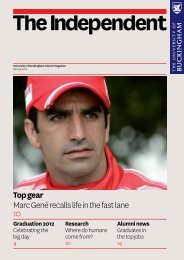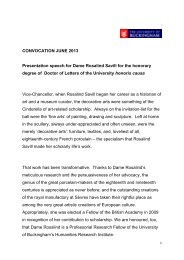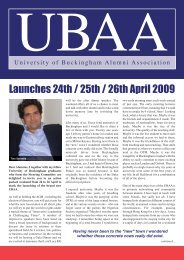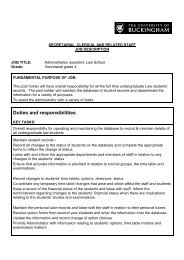Autumn 2011 - University of Buckingham
Autumn 2011 - University of Buckingham
Autumn 2011 - University of Buckingham
Create successful ePaper yourself
Turn your PDF publications into a flip-book with our unique Google optimized e-Paper software.
Proud lab head, Pr<strong>of</strong>essor Mike Cawthorne<br />
How to solve a<br />
global epidemic<br />
Justine Kibler meets the scientists<br />
who are trying to crack diabetes<br />
Mike Cawthorne is trying to tackle one <strong>of</strong><br />
the world’s big killer diseases affecting<br />
more than 300 million people globally.<br />
Diabetes is known to increase the risk<br />
<strong>of</strong> heart attack, kidney failure, male<br />
impotence and blindness, and there is<br />
as yet no cure for it.<br />
“The solution is to treat it as early as<br />
possible”, says Mike, who is head <strong>of</strong> The<br />
Clore Lab.<br />
At the Clore Lab he and his team aim to<br />
do just that by developing effective forms<br />
<strong>of</strong> diagnosis and treatment against type 2<br />
diabetes and obesity.<br />
This year the Lab is 25 years old and<br />
Pr<strong>of</strong>essor Cawthorne is proud <strong>of</strong> its<br />
discoveries. His ambition is to find a drug<br />
to revolutionise the way we treat a disease<br />
that is growing fast. An eminent<br />
biochemist, Mike Cawthorne is a world<br />
authority in discovering new drugs for<br />
metabolic diseases. He is credited with<br />
leading a research team that discovered<br />
the multi-million pound drug rosiglitazone,<br />
sales <strong>of</strong> which reached over £1.5 bn in one<br />
year alone, and became Head <strong>of</strong> the Clore<br />
Laboratory in 1994.<br />
From his hugely successful career in<br />
the pharmaceutical industry Mike created<br />
collaborations with prominent<br />
pharmaceutical companies and<br />
universities, making research into<br />
metabolic diseases the centre <strong>of</strong> attention<br />
– all <strong>of</strong> which led to the lab’s subsequent<br />
growth and success.<br />
Combating obesity at birth<br />
In April 2007 word had spread in the media<br />
about a “fat-fighting” baby milk made to<br />
prevent obesity in later life. “This was one<br />
<strong>of</strong> our most publicised topics,” Mike recalls,<br />
“and it saw over 200 newspaper<br />
appearances.” It refers to the area <strong>of</strong><br />
research at the laboratory that looks into<br />
the possibility that people can have a<br />
predisposition to obesity before they are<br />
even born.<br />
Researchers found that undernourished,<br />
small-for-date babies have a greater<br />
chance <strong>of</strong> becoming obese in later life if<br />
they are then overfed. Breast-fed babies<br />
are less likely to become obese than those<br />
fed on formula milk, which led the team to<br />
think that there must be a crucial<br />
ingredient missing at this stage <strong>of</strong> life that<br />
can affect their metabolism at a later date.<br />
Further research by the Clore Lab<br />
suggests that leptin is the missing hormone<br />
needed to combat obesity. Leptin is<br />
a hormone that controls appetite and<br />
metabolism, and is found naturally in<br />
breast milk. Though the research is still<br />
in its early stages, there is evidence to<br />
suggest that giving infants or pregnant<br />
mothers a supply <strong>of</strong> leptin can help to<br />
hardwire the infant brain to manage obesity<br />
in the future.<br />
Plant therapies<br />
Plants may also be able to provide<br />
treatment for diabetes and obesity. A large<br />
number <strong>of</strong> drugs available today for many<br />
diseases have their origins in plant and<br />
microbe material. Over the past few years<br />
the Clore Lab has worked on a number <strong>of</strong><br />
plant-based treatments including a cactus<br />
juice taken by Kalahari bushmen to stave<br />
<strong>of</strong>f hunger pangs. Currently the group are<br />
examining various non-psychoactive<br />
components <strong>of</strong> the cannabis plant.<br />
In 2009 the Clore Laboratory set up<br />
an alliance with GW Pharmaceuticals<br />
(a company whose aim is to develop<br />
prescription cannabinoid medicines)<br />
in order to investigate their potential.<br />
Provisional research shows that two<br />
particular cannabinoids produce many<br />
beneficial effects on the metabolism.<br />
They appear to reduce weight gain,<br />
increase energy expenditure, and even<br />
reduce cholesterol. Moreover, they may<br />
play a part in treating fatty liver disease<br />
and regulating insulin levels in plasma.<br />
As a result <strong>of</strong> the success <strong>of</strong> these<br />
initial findings at the Clore Lab, GW<br />
Pharmaceuticals are conducting clinical<br />
trials. They state on their website that<br />
“a number <strong>of</strong> components <strong>of</strong> the metabolic<br />
syndrome can potentially be addressed<br />
with a single medicine”.<br />
A new research direction<br />
Computers have <strong>of</strong>ten been accused <strong>of</strong><br />
shrinking the world around us, but now at<br />
the Clore Lab such technology is expanding<br />
the world within us. Owing to a generous<br />
donation over a year ago, Kenny Langlands<br />
and a small team are broadening the<br />
laboratory’s research areas. They want to<br />
change the way we diagnose and treat<br />
diseases using computerised gene maps.<br />
The CVs<br />
Pr<strong>of</strong>essor Mike Cawthorne received his<br />
PhD from the Royal Free Hospital, London.<br />
His record in the pharmaceutical industry<br />
stretches back decades; he worked for<br />
Beecham and then SmithKline Beecham<br />
for over 25 years and became group<br />
director for diabetes and obesity research.<br />
In 2001 he received the Society for<br />
Medicines Research Award for Drug<br />
Discovery.<br />
Mike’s interest lies in discovering and<br />
developing new medicines. One <strong>of</strong> his<br />
approaches is in unlocking the potential<br />
<strong>of</strong> plants to treat metabolic diseases.<br />
This type <strong>of</strong> natural and low technology<br />
medicine would benefit those in<br />
developing countries (who are predicted<br />
to have the highest number <strong>of</strong> diabetics<br />
soon) as they are not able to obtain many<br />
types <strong>of</strong> Western medicine.<br />
Mr David Hislop worked alongside Anne<br />
Bel<strong>of</strong>f-Chain at Imperial College and was<br />
one <strong>of</strong> three people whom she brought to<br />
the lab when it opened in 1986. Now<br />
laboratory manager, he enjoys working at<br />
Researchers found that<br />
undernourished babies<br />
have a greater chance <strong>of</strong><br />
becoming obese if they<br />
are overfed<br />
A researcher in the lab<br />
Huge biological feats are now being<br />
achieved with the aid <strong>of</strong> computers.<br />
Following the success <strong>of</strong> the Human<br />
Genome Project (an international research<br />
project whose goal was to map electronically<br />
all <strong>of</strong> the genetic material that makes us<br />
human), the team are working out how<br />
genes act in diseased skin cells, starting with<br />
skin cancer. Could it be that genes always<br />
affect cancers in the same way<br />
Biopsies are taken from damaged or<br />
cancerous skin cells and the team identify<br />
which genes are turned on and <strong>of</strong>f compared<br />
to genes in normal skin. Using computer<br />
technology they pr<strong>of</strong>ile all the genes in a<br />
cancerous cell several times over in an<br />
attempt to find a pattern between them<br />
<strong>Buckingham</strong> now as much as did when he<br />
began. “No two days are ever the same<br />
here”, he says.<br />
One <strong>of</strong> the biggest changes he<br />
witnessed was the replacement <strong>of</strong> Anne<br />
Bel<strong>of</strong>f-Chain by Pr<strong>of</strong>essor Mike Cawthorne.<br />
“He really strengthened the research side<br />
<strong>of</strong> things and brought in a lot <strong>of</strong> funding”.<br />
Dr Kenneth Langlands studied Genetics<br />
at Edinburgh <strong>University</strong> and began his<br />
research career by developing methods to<br />
detect leukaemia. He has worked at<br />
children’s hospitals in Bristol and<br />
Pittsburgh and joined the Biochemistry<br />
department at Cambridge in 1997.<br />
As head <strong>of</strong> Bioinformatics, he came to<br />
the Clore Lab to pursue his own<br />
dermatological and computational biology<br />
research with the aim <strong>of</strong> improving patient<br />
treatment and diagnosis by creating a<br />
more accurate way <strong>of</strong> identifying and<br />
predicting diseases. He would also like to<br />
develop “an internationally regarded<br />
medical school at <strong>Buckingham</strong> with an<br />
emphasis on teaching”.<br />
and perhaps create a template from this.<br />
If there is a template or “gene map” for<br />
something such as cancer, the implications<br />
are vast. Patients would be diagnosed<br />
quicker and more accurately, increasing<br />
their chances <strong>of</strong> a successful recovery.<br />
By studying patients’ damaged cells and<br />
genes, scientists could also find out how,<br />
exactly, the body is affected and so create<br />
personalised treatment and therapies.<br />
It could even map out susceptibility to<br />
diseases such as diabetes, and consequently<br />
be used to prevent future problems.<br />
History <strong>of</strong> the Clore Lab<br />
It was a quarter <strong>of</strong> a century ago that the<br />
Clore Lab was erected after the highly<br />
regarded biochemist Pr<strong>of</strong>essor Anne<br />
Bel<strong>of</strong>f-Chain chose the <strong>University</strong> as the<br />
location for a new laboratory. Her brother<br />
was Max Bel<strong>of</strong>f, the <strong>University</strong>’s first<br />
principal. Her interest in biochemistry<br />
developed from a family friend and her<br />
eventual husband, Sir Ernst Chain, whose<br />
research into penicillin in later years won<br />
him the Nobel Prize in Physiology and<br />
Medicine alongside Sir Alexander Fleming<br />
and Sir Howard Florey.<br />
Metabolic diseases became her research<br />
focus when she worked at Harvard Medical<br />
School in the 1940s. She started the new<br />
department <strong>of</strong> biochemistry with Ernst Chain<br />
at Imperial College, London in 1964 and<br />
spent more than 20 years there, making<br />
significant progress in the field <strong>of</strong> insulin<br />
resistance and production.<br />
Anne was still making biochemical<br />
advances right up the time when she retired<br />
from the department in 1986. She therefore<br />
decided to find a new laboratory from which<br />
to carry out further work. After speaking to<br />
her brother, Max, she chose to come to<br />
<strong>Buckingham</strong>.<br />
Building the laboratory from scratch was<br />
no easy task. It relied on a number <strong>of</strong> kind<br />
benefactors in addition to Anne’s personal<br />
funding and efforts. One <strong>of</strong> its most<br />
prominent donators was Vivien Duffield, the<br />
philanthropist known for her donations to<br />
charities and arts organisations who gave<br />
more than £250,000 from her father’s Clore<br />
Foundation towards the building <strong>of</strong> the<br />
laboratory. That is why it was named the<br />
Clore Laboratory.<br />
Anne had set up residence at the Clore<br />
Laboratory by 1986 and brought with her<br />
three research fellows from Imperial. She<br />
remained at the Lab until her death in 1992.<br />
Since opening, the laboratory has been<br />
defined by its academic intellectual freedom.<br />
We only take on research areas that are <strong>of</strong><br />
interest to us, says Kenny Langlands, and<br />
this is because <strong>of</strong> <strong>Buckingham</strong>’s<br />
independence. It means that the lab is not<br />
restricted by government agencies. “It’s the<br />
freedom for academics to plough their own<br />
furrow”, he explains, “because they<br />
themselves are able to bring in funding, to<br />
find areas <strong>of</strong> interest, to establish networks<br />
and collaborations”. Today is an exciting<br />
time to be at the Clore Laboratory.<br />
14 The Independent The Independent 15

















